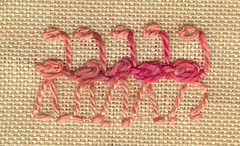OMG is that background what I think it is? It is if you're thinking towel! I made a batch of Earl Grey tea stain the other day and couldn't just pour the leftover down the drain. What was handy was a threadbare dish, er, tea towel I'd used as a blotter from my last dye session. "I wonder what it would be like to stitch on?", I mused as I stuffed it into the Pyrex measuring cup that held the tea. As soon as the towel was rinsed and dried I found out.
I finished Week 12 early, so I was happy to keep my fingers from wriggling in anticipation of Monday Night and the latest
TAST temptation. I worried (not really, this was a rag!) about embroidery needles and sharp points catching on tiny, terry loops, but since the velour finish had long ago worn away from the printed front side, the fabric was very giving and yielded to my large tapestry/yarn needles with ease. For this sampler I ended up using only #5 perle cottons and fingering weight wool/silk yarns.
About 2/3's down I started a line of twisted chain. I wanted a little more height so I layered a second row right on top. You can see I got much better dimension with yarn seen in the single layer of twisted chain below (brown). The gray line is knotted buttonhole stitch threaded with a piece shiny raffia, probably something that once tied up a package. Seems like I had just gotten down that charcoal line of Sorbello than twas time to download
Week 13, Raised Cup Stitch! Am I the only one who has a pavlovian response to Sharon B's challenge posts?
I got all of those raised cups stitched waiting in a doctor's office for DH. They are all worked with the silk & wool yarns. I love their organic shapes, how they flop and smoosh together. The white one in the center is an example of decreasing to make the cup turn inward. The coppery bit you see are "stamens" emanating from a French knot. I added irregular cretan stitching awaiting DH's lab work the next day, routine medical, btw. I was satisfied that that finished the upper portion, but had to experiment a bit to get the rest as you see below.
I tried couching down some pussy willow yarn, had a little spiral going, but the color seemed to light. I made it worse by weaving in a darker yarn. Ugh. Check out the raised cup centers, wooden and agate beads too big, faux pewter spacer beads. No, no, no. Too fussy. Not in keeping with the rustic look I wanted.
What was I thinking? That thing ,btw, is a freeform crocheted motif that's been waiting around forever to unite with its kind to become a scrumble.
So I end up with unfilled cups and graduated French knots on the bottom. Swapped out some of the beads in the other row with French knots -- and
a bullion (white cup on the left!).
And now a sort of tutorial. Working the raised cup stitch reminded me of a motif I learned a few years back on the
CQ Embellishers forum. I was thrilled to make it, especially since I hadn't learned any fancy stitches. The other Embelles used this effectively as sea anenomes in some of their wonderful underwater fantasies. The motif is so simple, it really doesn't require illustration.
Thread a tapestry needle with yarn or chunky thread. I find this easiest to do on my left index or little finger, but a pencil could be used instead. Begin at the top finger joint and wrap the yarn upwards about four times, covering the tail as you go. Wraps should be loose enough for you to work the needle underneath. Pass the needle downwards behind the wraps, holding the top coil with another finger. Now work around buttonhole stitch around, pushing the
stitches close together. When the round is completed, weave in the end. You now have a little ring motif you can stitch to your work and embellish with beads. I used to like to make these using a funky variegated yarn, sparkly and frizzy. They can also be used to make little nests as in the example below
This is from my project for Sharon Boggan's
Encrusted Crazy Quilting class. If you haven't tried one her courses, you do not know what you're missing. They are outstanding and comparable to a semester of study complete with textbook.







+of+scan.jpg)







































